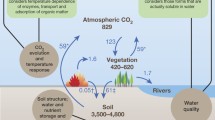Abstract
Prior generalizations about the ecological roles of monoterpenes may be misleading if based on the presumed insolubility of monoterpenes in water. We determined the aqueous solubility of 31 biologically active monoterpenes by gas chromatography. While hydrocarbons were of low solubility (< 35 ppm), oxygenated monoterpenes exhibited solubilities one or two orders of magnitude higher, with ranges of 155–6990 ppm for ketones and of 183–1360 ppm for alcohols. Many monoterpenes are phytotoxic in concentrations under 100 ppm, well below the saturated aqueous concentrations of oxygenated monoterpenes. Therefore, even dilute, unsaturated solutions of monoterpenes, occurring naturally in plant tissues and soil solutions, may act as potent biological inhibitors.
Similar content being viewed by others
References
Blum, U., andDalton, B.R. 1985. Effects of ferulic acid, an allelopathic compound, on leaf expansion of cucumber seedlings, grown in nutrient culture.J. Chem. Ecol. 10:1169–1191.
Budavari, S. (ed.) 1989. Merck Index, 11th ed. Merck & Co., Rahway, New Jersey.
Davis, E.F. 1928. The toxic principle ofJuglans nigra as identified with synthetic juglone, and its toxic effects on tomato and alfalfa plants.Am. J. Bot. 15:620.
Dev, S. (ed.) 1982. CRC Handbook of Terpenoids, Monoterpenoids. CRC Press, Boca Raton, Florida.
Eisner, T. 1964. Catnip: Its raison d'Être.Science 146:1318–1320.
Fischer, N.H. 1991. Plant terpenoids as allelopathic agents, pp. 377–398,in J.B. Harborne and F.A. Tomas-Barberan (eds.). Ecological Chemistry and Biochemistry of Plant Terpenoids. Oxford University Press, Oxford.
Fischer, N.H.,Tanrisever, N., andWilliamson, G.B. 1988. Allelopathy in the Florida scrub community as a model for natural herbicide actions, pp. 233–249,in H. Cutler (ed.). Natural Products: Potential in Agriculture. American Chemical Society Symposium Series 380, Washington, D.C.
Fischer, N.H., Williamson, G.B., Tanrisever, N., De la Pena, A., Weidenhamer, J.D., Jordan, E.D., andRichardson, D.R. 1989. Allelopathic actions in the Florida scrub community.Biol. Plant. 31(6):471–478.
Gant, R.E., andClebsch, E.E.C. 1975. The allelopathic influences ofSassafras albidum in oldfield succession in Tennessee.Ecology 56:604–615.
Harborne, J.B. 1984. Phytochemical Methods, 2nd ed. Chapman and Hall, London.
Harborne, J.B. 1988. Introduction to Ecological Biochemistry, 3rd ed. Academic Press, London.
Horner, J.D., Gosz, J.R., andCates, R.G. 1988. The role of carbon-based plant secondary metabolites in decomposition in terrestrial ecosystems.Am. Nat. 132(6):869–883.
Macias, F.A., Fronczek, F.R., andFischer, N.H. 1989. Menthofurans fromCalamintha ashei and the absolute configuration of desacetylcalaminthone.Phytochemistry 28:79–82.
McPherson, J.K., Chou, C.H., andMuller, C.H. 1971. Allelopathic constituents of the chaparral shrubAdenostoma fasciculatum.Phytochemistry. 10:2925–2933.
Muller, C.H., andChou, C.-H. 1972. Phytoalexins: An ecological phase of phytochemistry, pp. 201–216,in J.B. Harborne (ed.). Phytochemical Ecology. Academic Press, London.
Muller, C.H. 1965. Inhibitory terpenes volatilized fromSalvia shrubs.Bull. Torr. Bot. Club 92(l):38–45.
Muller, C.H., Muller, W.H., andHaines, B.L. 1964. Volatile growth inhibitors produced by aromatic shrubs.Science 143:471–473.
Muller, W.H. 1965. Volatile materials produced bySalvia leucophylla: Effects on seedling growth and soil bacteria.Bot. Gaz. 126(3):195–200.
National Research Council. 1971. Involvement of soils and organisms in allelopathy. Report by a study committee, pp. 1–8,in Biochemical Interactions among Plants. National Research Council, National Academy of Science, Washington, D.C.
Rhode, H. 1922. Löslichkeit, CapillaraktivitÄt und hÄmolytische Wirksamkeit bei Terpenderivaten.Biochem. Z. 130:481–496.
Richardson, D.R., andWilliamson, G.B. 1988. Allelopathic effects of shrubs of the sand pine scrub on pines and grasses of the sandhills.For. Sci. 34(3):592–605.
SASInstitute, Inc. 1985. SAS User's Guide: Statistics, Version 5 Edition. Cary, North Carolina.
Seidell, A. 1940–41. Solubilities of Organic Compounds, 3rd ed, Vol. II. D. Van Nostrand, New York.
Smyrl, T.G., andLeMaguer, M. 1980. Solubilities of terpenic essential oil components in aqueous solutions.J. Chem. Eng. Data 25:150–152.
Tanrisever, N., Fronczek, F.R., Fischer, N.H., andWilliamson, G.B. 1987. Ceratiolin and other flavonoids fromCeratiola ericoides.Phytochemistry 26(1):175–179.
Tanrisever, N., Fischer, N.H., andWilliamson, G.B. 1988. Menthofurans fromCalamintha ashei: Effects onSchizachyrium scoparium andLactuca sativa.Phytochemistry 27(8):2523–2526.
Tukey, H.B., Jr. 1969. Implications of allelopathy in agricultural plant science.Bot. Rev. 35:1–16.
Weast, R.C. (ed.) 1976. CRC Handbook of Physics and Chemistry, 57th ed. CRC Press, Cleveland, Ohio.
Weast, R.C. (ed.) 1989. CRC Handbook of Physics and Chemistry, 70th ed. CRC Press, Boca Raton, Florida.
Whittaker, R.H. 1971. The chemistry of communities, pp. 10–18,in Biochemical Interactions among Plants. National Research Council, National Academy of Science, Washington, D.C.
Williamson, G.B., Fischer, N.H., Richardson, D.R., andDe la Pena, A. 1989. Chemical inhibition of fire-prone grasses by fire-sensitive shrub,Conradina canescens.J. Chem. Ecol. 15(5):1567–1577.
Williamson, G.B., Richardson, D.R., andFischer, N.H. 1992. Allelopathic mechanisms in fire-prone communities, pp. 58–75,in S.J.H. Rizvi and V. Rizvi (eds.). Allelopathy: Basic and Applied Aspects. Chapman and Hall, London.
Author information
Authors and Affiliations
Rights and permissions
About this article
Cite this article
Weidenhamer, J.D., Macias, F.A., Fischer, N.H. et al. Just how insoluble are monoterpenes?. J Chem Ecol 19, 1799–1807 (1993). https://doi.org/10.1007/BF00982309
Issue Date:
DOI: https://doi.org/10.1007/BF00982309




